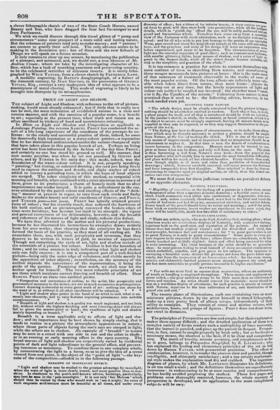FINE ARTS.
THE season for art, as for every thing else, is over: the last exhibi- tion, and the best—the pictures by the Old Masters at the British In- stitution—closes to-day. Publication is at a stand till the Annuals appear; and, excepting Pnou'r's work, that is more fully noticed below, the few novelties are trivial and miscellaneous. The sketchers are setting out on their tours : Lewis, who has been spending the sea• son in Paris, has departed for the East ; lloimers is gone in the same direction ; and STANEIELD is bound for Sicily. The Illustrations of Mr. GALLY KNIGHT.S tour in search of the Nerman Remains in Sicily, give us new ideas of Sicilian architecture. The elegant combinations of 'Moorish domes and arches and Arabesque decorations with Greek columns in Norman buildings, show what unity of effect may result from the union of different styles that seem et first incongruous. The plates are lithographed in the tinted style, from drawings by Mr. G. B. Moon:, an architect and artist of considerable talent, who accompanied Mr. KNIGHT in his tour. Only two parts of the work have as yet appeared, however; and Sicily abounds with picturesque features of other kinds.
We should be glad to hear of some artists illustrating the scenery
and antiquities of our own country in this style. TURNER'S series of Views in England and Wales is now completed ; and a work more rich in beauties both of nature and art does not exist. TURNER'S colour is extravagant, but the magical tones of his atmospheric effects of light and shade, so aerial and transient, have not the drawback of his vicious exaggeration of hues to contend against in the black and white of the engraving ; and if his views be not literally and locally correct, the general aspect is true to nature in the abstract. HARDING'S pretty Illustrations of Coween made us long for some English scenes from his bold and graceful pencil; such as constitute the " at home " portion of his book of Sketches. We are inundated with common and cheap works got up for sale; but English scenery fares worse than any in point of really fine art. Such little popular periodicals as Carter's Views of Windsor, with neat copperplates and flowery descriptions by Roscoe, are very well in their way ; but we desire to see the architec- turid and landscape beauties of our country reflected in a larger and more polished mirror. Among the omniumgatherum of Prints, is another portrait of the Queen—Ohe join satis.'—by AGI.I0, who, we suppose, intends in the composition of the picture to exemplify the comparison of the three estates to a pyramid : the Queen in her robes, as its apex, forms a sort of triangle, whose base is the throne. The public are only wait- ing the issue of the new coinage to be sated with the sight of her Majesty's effigies. Meanwhile, we forget all the other likenesses; as we look at CHALON'S state portrait, now engraved in mezzotint by COUSINS : beautiful as is the plate, however, it is but the shadow of the gorgeous original.
Among other consequences of a new reign, the Shows of Royalty are
being pictured. GEORGE liserett has set aside his Parliamentary omnibus for a while, and got upon a more splendid vehicle of portraiture,
a grand picture of the Coronation ; for which the Queen and the courtiers are sitting in their state robes. Dieirrox, who delineated the two last Installations at Oxford and Cambridge, is at work on a view of the Civic Banquet to her Majesty; the outline of which is already
put forth. BAXTER, the ingenious picture-printer, is engraving a set of wood blocks to give impressions in colours of the Queen opening the Parliament. The Coronation Procession is measured out by the yard at the corners of the streets. And Mr, SCANLAN has published a clever lithographic sketch of two of the State Coach Horses, named Beauty and Star, who have dragged the four last Sovereigns'to and from Parliament.
We wish we could discern through this tinsel glitter of " pomp and circumstance" some near prospect of a more solid and lasting nature. But the schemes of painters tend only to make money ; and " patrons " are content to gratify their self.love. The only advance seems to be making in the decorative arts : but of these and the new Schools of Design we will speak on a future occasion. It only remains to clear tip our arrears, by mentioning the publication of a pleasant, and animated, and, we doubt not, a true likeness of Mr. Andrew Crosse; whom we take by the investigating character of his face, which has a look of searching exactness and persevering scrutiny, to be the celebrated revivifier of siliceous insects. It is nicely litho. graphed by WELD TAYLOR, from a clever sketch by FREDERICK LANE. A medallic engraving, by BarEs's Anaglyptograph, of a Salver of the sixteenth century, by JEAN GoesoN, in the possession of GEORGE VIVIAN, Esq., conveys a very inadequate idea of what appears to be a masterpiece of metatchasing. This mode of engraving is likely to be brought into disrepute by its misapplication.



























 Previous page
Previous page